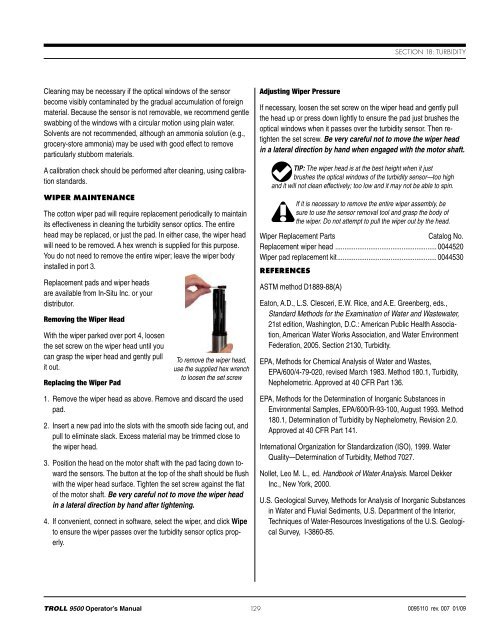TROLL 9500 Operator's Manual - Geotech Environmental Equipment
TROLL 9500 Operator's Manual - Geotech Environmental Equipment
TROLL 9500 Operator's Manual - Geotech Environmental Equipment
You also want an ePaper? Increase the reach of your titles
YUMPU automatically turns print PDFs into web optimized ePapers that Google loves.
Section 18: TurbidityCleaning may be necessary if the optical windows of the sensorbecome visibly contaminated by the gradual accumulation of foreignmaterial. Because the sensor is not removable, we recommend gentleswabbing of the windows with a circular motion using plain water.Solvents are not recommended, although an ammonia solution (e.g.,grocery-store ammonia) may be used with good effect to removeparticularly stubborn materials.A calibration check should be performed after cleaning, using calibrationstandards.Wiper MaintenanceThe cotton wiper pad will require replacement periodically to maintainits effectiveness in cleaning the turbidity sensor optics. The entirehead may be replaced, or just the pad. In either case, the wiper headwill need to be removed. A hex wrench is supplied for this purpose.You do not need to remove the entire wiper; leave the wiper bodyinstalled in port 3.Replacement pads and wiper headsare available from In-Situ Inc. or yourdistributor.Removing the Wiper HeadWith the wiper parked over port 4, loosenthe set screw on the wiper head until youcan grasp the wiper head and gently pullit out.Replacing the Wiper PadTo remove the wiper head,use the supplied hex wrenchto loosen the set screw1. Remove the wiper head as above. Remove and discard the usedpad.2. Insert a new pad into the slots with the smooth side facing out, andpull to eliminate slack. Excess material may be trimmed close tothe wiper head.3. Position the head on the motor shaft with the pad facing down towardthe sensors. The button at the top of the shaft should be flushwith the wiper head surface. Tighten the set screw against the flatof the motor shaft. Be very careful not to move the wiper headin a lateral direction by hand after tightening.4. If convenient, connect in software, select the wiper, and click Wipeto ensure the wiper passes over the turbidity sensor optics properly.Adjusting Wiper PressureIf necessary, loosen the set screw on the wiper head and gently pullthe head up or press down lightly to ensure the pad just brushes theoptical windows when it passes over the turbidity sensor. Then retightenthe set screw. Be very careful not to move the wiper headin a lateral direction by hand when engaged with the motor shaft.TIP: The wiper head is at the best height when it justbrushes the optical windows of the turbidity sensor—too highand it will not clean effectively; too low and it may not be able to spin.If it is necessary to remove the entire wiper assembly, besure to use the sensor removal tool and grasp the body ofthe wiper. Do not attempt to pull the wiper out by the head.Wiper Replacement PartsCatalog No.Replacement wiper head ....................................................... 0044520Wiper pad replacement kit...................................................... 0044530ReferencesASTM method D1889-88(A)Eaton, A.D., L.S. Clesceri, E.W. Rice, and A.E. Greenberg, eds.,Standard Methods for the Examination of Water and Wastewater,21st edition, Washington, D.C.: American Public Health Association,American Water Works Association, and Water EnvironmentFederation, 2005. Section 2130, Turbidity.EPA, Methods for Chemical Analysis of Water and Wastes,EPA/600/4-79-020, revised March 1983. Method 180.1, Turbidity,Nephelometric. Approved at 40 CFR Part 136.EPA, Methods for the Determination of Inorganic Substances in<strong>Environmental</strong> Samples, EPA/600/R-93-100, August 1993. Method180.1, Determination of Turbidity by Nephelometry, Revision 2.0.Approved at 40 CFR Part 141.International Organization for Standardization (ISO), 1999. WaterQuality—Determination of Turbidity, Method 7027.Nollet, Leo M. L., ed. Handbook of Water Analysis. Marcel DekkerInc., New York, 2000.U.S. Geological Survey, Methods for Analysis of Inorganic Substancesin Water and Fluvial Sediments, U.S. Department of the Interior,Techniques of Water-Resources Investigations of the U.S. GeologicalSurvey, I-3860-85.<strong>TROLL</strong> <strong>9500</strong> Operator’s <strong>Manual</strong> 1290095110 rev. 007 01/09
















